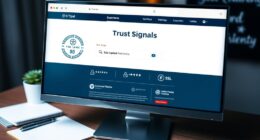Are you having difficulty resolving irritating technical SEO issues? You’ve come to the right place!
In this article, we will guide you through the process of analyzing and resolving common issues that may be hindering your website’s performance.
From broken links and redirect errors to duplicate content and slow page speed, we’ve got you covered.
Get ready to optimize your meta tags and headers, and achieve the liberation your website deserves!

Key Takeaways
- Clear and logical site structure improves crawlability and ranking in search results.
- Identifying and fixing broken links and redirects is crucial for ensuring a smooth user experience and search engine optimization.
- Addressing duplicate content issues, such as implementing canonical tags and monitoring for content scraping, helps maintain unique and valuable content.
- Optimizing page speed and performance through techniques like enabling browser caching, compressing images, and utilizing CDNs can enhance user experience and SEO.
Analyzing Your Website’s Technical SEO
Now let’s delve into the process of analyzing our website’s technical SEO.
Understanding crawlability and indexing is crucial in optimizing our website for search engines. Crawlability refers to how easily search engine bots can navigate and access our website’s pages. By ensuring that our website has a clear and logical site structure, we can improve crawlability and enhance our chances of ranking higher in search results.
Indexing, on the other hand, involves search engines storing and organizing our web pages in their database. Implementing structured data markup is another essential aspect of technical SEO analysis. By adding structured data to our website’s code, we provide search engines with additional information about our content, making it easier for them to understand and display relevant results to users.
Fixing Broken Links and Redirect Errors
To address broken links and redirect errors, we need to tackle the task of fixing them promptly. This is crucial for ensuring a smooth user experience and maintaining a healthy website.

When it comes to fixing crawl errors and troubleshooting indexing issues, there are several key steps to follow:
- Identify broken links and redirects using a website crawler or SEO auditing tool.
- Update or remove the broken links to ensure they lead to relevant and functional pages.
- Implement 301 redirects to redirect users and search engines from outdated or broken URLs to the correct pages.
- Regularly monitor and test your website to catch any new crawl errors or redirect issues.
Resolving Duplicate Content Issues
To resolve duplicate content issues, we need to analyze and address the root causes of content duplication on our website. One common cause is the lack of canonical tags, which are HTML tags that tell search engines which version of a page should be considered the original. By implementing canonical tags correctly, we can avoid content duplication caused by variations of the same page URL.
Another cause of duplicate content is content scraping, where other websites copy our content without permission. To combat this, we can monitor our website for instances of content scraping and take appropriate action, such as requesting removal or filing a DMCA complaint.
By proactively addressing these issues, we can ensure that our website provides unique and valuable content to users and search engines alike.

Now, let’s move on to improving page speed and performance.
Improving Page Speed and Performance
To optimize page speed and performance, we need to enhance the loading time and overall functionality of our website. Here are some techniques and strategies to achieve this:
- Website caching techniques:
- Enable browser caching to store static files locally and reduce server requests.
- Implement server-side caching to generate and serve cached versions of web pages.
- Utilize content delivery networks (CDNs) to cache and distribute website content globally.
- Mobile optimization strategies:
- Use responsive web design to ensure your website adapts to different screen sizes.
- Compress images and optimize code to reduce file sizes and improve loading speed on mobile devices.
- Implement lazy loading to defer the loading of non-essential elements until they’re needed.
Optimizing Meta Tags and Headers
We can optimize meta tags and headers to improve our website’s technical SEO.
Improving keyword density in meta tags can help search engines understand the relevance of our content to specific keywords. By including relevant keywords in our meta tags, we can increase the chances of our website being found by users searching for those keywords.

Additionally, optimizing headers with relevant keywords can enhance the user experience by providing clear and concise information about the content on each page. Users can quickly scan the headers to determine if the page is relevant to their needs. This can reduce bounce rates and increase the time users spend on our website, ultimately improving our overall SEO performance.
Frequently Asked Questions
How Can I Resolve Indexing Issues on My Website?
We can troubleshoot website indexing problems by resolving crawl errors and improving website visibility. This involves identifying and fixing technical SEO errors to ensure that search engines can properly index and rank our website.
What Are Some Common Causes of Crawl Errors and How Can I Fix Them?
Common causes of crawl errors include broken links, server errors, and blocked resources. To fix these issues, we recommend regularly monitoring your website, fixing broken links, resolving server errors, and ensuring that all resources are accessible to search engines.
How Do I Ensure Proper URL Canonicalization?
To ensure proper URL canonicalization, we implement a proper URL structure and use canonical tags. This helps search engines understand the preferred version of a URL, avoiding duplicate content issues and improving SEO performance.

Are There Any Specific Techniques to Optimize Javascript and CSS Files for Better Website Performance?
To improve website loading speed, we optimize JavaScript and CSS files. Minify, compress, and combine these files to reduce their size. Additionally, we prioritize loading critical resources and utilize caching techniques for faster performance.
What Are the Best Practices for Optimizing Image Files on My Website for Improved Page Speed?
To optimize image files for improved page speed, we use image compression techniques. Alt tags play a crucial role in SEO by providing context to search engines. These practices enhance website performance and user experience.
Conclusion
In conclusion, fixing technical SEO errors is crucial for improving the overall performance and visibility of a website.
Just like a well-maintained engine ensures a smooth and efficient car ride, addressing broken links, duplicate content, page speed, and optimizing meta tags and headers ensures a seamless user experience and better search engine rankings.

By regularly analyzing and resolving these issues, website owners can ensure their online presence remains strong and competitive.









